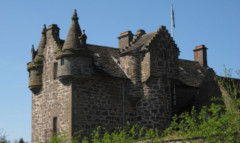Planners have approved “a vision” to improve the setting of an A-listed Angus castle.
Gardyne Castle was built as a 16th Century fortified tower by the Gardyne family of Leys, and was developed as a country house over the next two centuries by the Lyells of Dysart, whose descendants owned the estate until the 1960s.
Owner William Gray Muir and his wife have spent several years redeveloping the walled garden to sit alongside neighbouring estate gardens such as Pitmuies House.
Angus Council was approached over removal of a “crude” 1970s garage, the construction of a doocot and poolhouse to the north, and a rectangular pavilion to overlook and “formalise” the gardens, east of the public road from Guthrie to Arbroath.
The main building is distinctive, with gun ports and bartizans with a false parapet.
An out of position date-stone of AD 1568 bears the arms of James VI and the motto God Save the King, belying the Gardyne family’s position as officials in the Stewart monarch’s court.
Architects Simpson and Brown state the owners carried out work to repair the castle in 2003, and have “a vision” to make Gardyne “a beautiful and characteristic Scottish garden” in the tradition of east coast castles and country houses.
The architects add the estate has many “beautiful features” but “would look better” without a 1970s garage that has an “entirely alien appearance” in the setting.
Regarding the new buildings, Simpson and Brown argued that Renaissance castles were often surrounded by service and agricultural accommodation that was stripped away in later centuries.
“During the later 18th and 19th centuries the Scottish tower house became part of a national myth of a Romantic, warlike past,” say the architects.
“Each laird was supposed to have lived barricaded behind the thick walls of his castle, peering through the small windows across barren wastes, and venturing out only to do battle.
“The more prosaic reality of the tower house was as a place of some comfort and sophistication.”
Case officer Neil Duthie agreed with the removal and complementary nature of the new pavilion and added: “The applicant intends to formalise the walled garden associated with the listed building and the design is based on the tradition of Scots gardens, both from what is known of the attitudes and planting arrangements in the 17th and 18th centuries and the tradition of revival of Scots gardens often associated with Sir Robert Lorimer and his contemporaries in the Edwardian period.”
